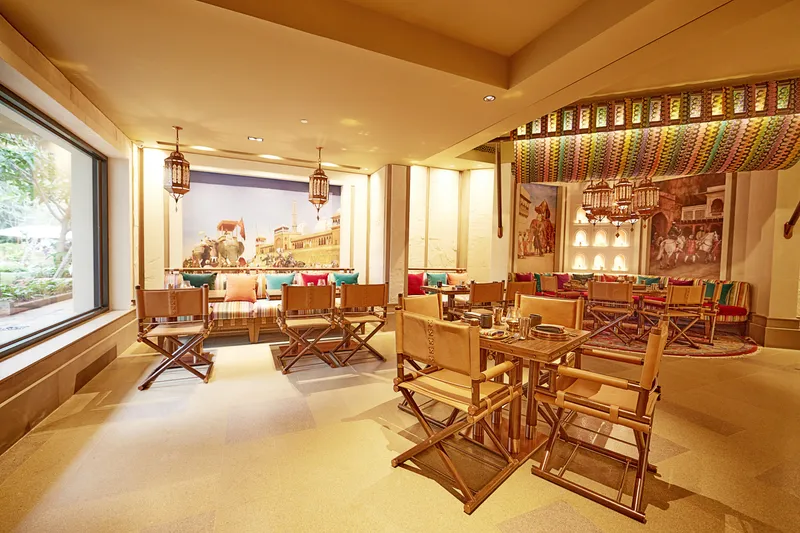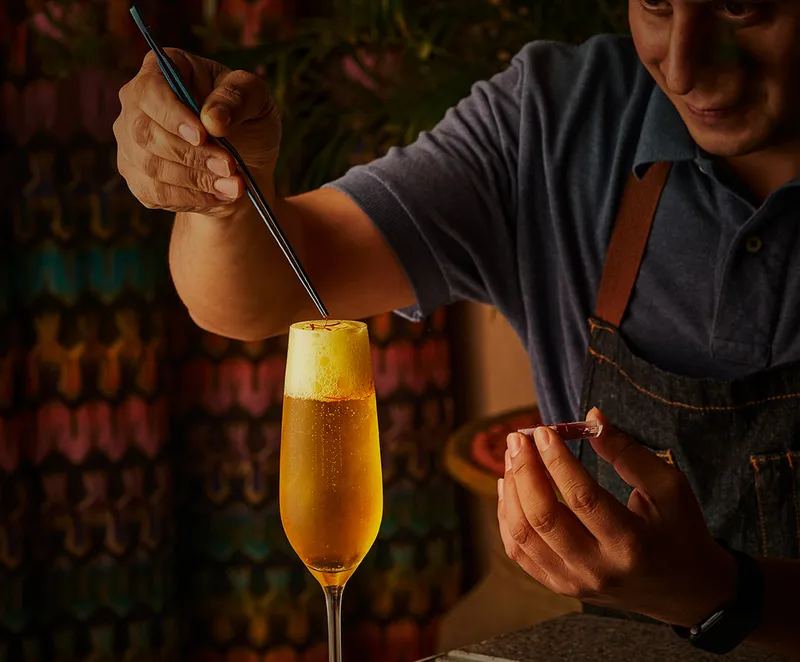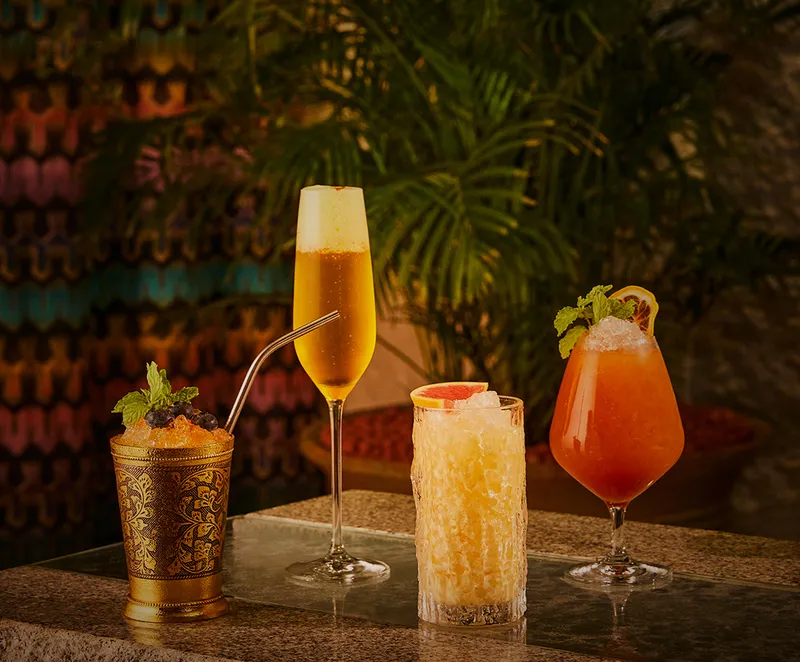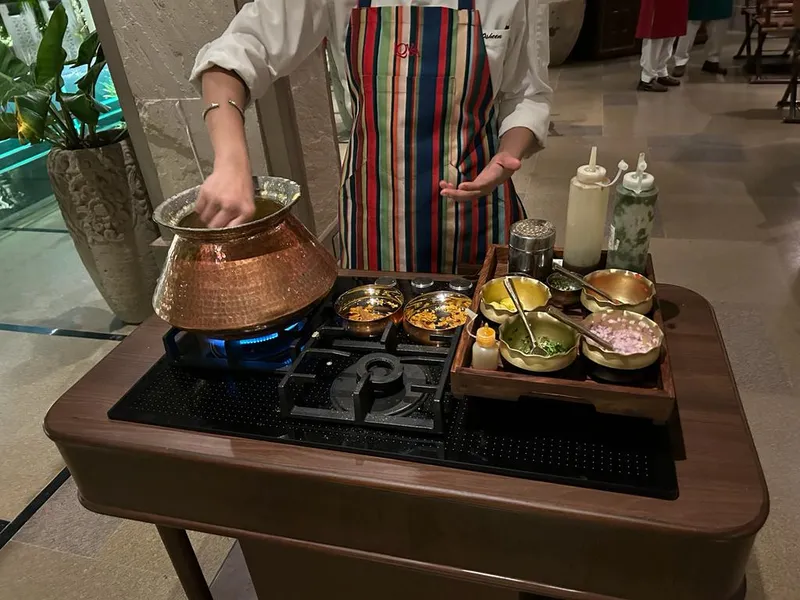Loya finds a new home at Bengaluru’s Taj West End
Taj West End’s Loya is a luxurious culinary experience featuring indigenous North Indian cuisine, with a fresh outlook and a reimagined presentation.
There is no doubt that India has a vast and diverse spread when it comes to food. However, as a South Indian, my knowledge of North Indian food is limited to a few dishes.
Ghee parathas, butter chicken, paneer butter masala, and chaat are my go-to answers whenever someone asks me what I know about this cuisine.
So, walking through the elaborate set-up at Loya in Bengaluru feels like a deep dive into the diversity of North Indian cuisine. It’s almost as if someone has cut out generous slices of all things North Indian and served them on a platter.
Right from the bazaar-themed decor–an ode to old traditional spice markets– to the table placements featuring the channi (strainer) and traditional oil lamps, the flavour of the North is unmissable.

Loya interiors | Image source: Indian Hotels Company (IHCL)
“We understood that Indian cuisines, especially in the northern parts, are not explored. So, we had to send out an entire team of chefs to research this field,” Fatima Abbas, Head of Marketing and Public Relations, at Loya tells YS Life. This team scoured the lengths and breadths of the northern region, gathering the intricate knowledge of different ingredients and techniques, which had remained unexplored for a number of years.
“With Loya we didn’t want everything to be solely about the food, but we also wanted people, once they enter the place, to feel the North Indian flavour in everything, whether it’s design, food, beverages … We want them to experience everything together.”
This thought process is evident from the design and decor of the entire space.
Right from the walls bearing ancient inscriptions from the region to the khatiya (cot)-themed placemats, there is great attention to detail across the board. The space also features exclusive zones, including the champagne room that offers bespoke services.
Then there is the quintessential Delhi lounge called Qissa, where patrons are encouraged to sit down and enjoy the space and share stories with each other—a practice drawn from the tradition of sitting down as the sun sets and bonding with one another.
Loya has taken this tradition up a notch by turning the lounge into an event space–where artists are called upon to share their stories. Most recently, Loya’s Delhi branch hosted filmmaker Muzzafar Ali to speak about his life.
The Bengaluru restaurant will also host such events once a month, promises Abbas.
HEART-y drinks
Drinks at Taj are an elaborate affair, following the philosophy of HEART, which stands for harmony, experimental, authentic, reverence, and the spirit. All drinks at Loya fall neatly into one of these categories, evoking the essence of North India along the way.
It is most noticeable in the Sparkling Sangria, a drink with gin and sparkling wine, with strands of saffron that lend a sweet and refreshing after-taste, and ingredients that originate from the hinterlands of the North.

The Sparkling Saffron | Image source: Loya Social Media
The Mulethi (liquorice) cocktail–a gin-based drink blended with an in-house citrus concoction–uses the herb it is named after.
The herb is used in several households in North India as a prolific Ayurvedic remedy for the common cold.
If you happen to glug a couple of drinks at the bar, you should try the tableside preparation of dal ki chaat, which serves as a perfect complement to any of the drinks on offer. Most drinks at Loya are accompanied by chaats that stimulate the palate. No peanuts or snacks here, says Dilbar Singh Rawat, the head mixologist at Loya.
The drinks on Loya’s menu are a unique mixology of forward, progressive cocktails, coupled with indigenous ingredients, thus making them unlike any other cocktails you would find in the city. I also found the incorporation of traditional salts as rims in cocktails quite fascinating.

Cocktails on offer at Loya. Image Credit: Loya social media.
Food from the Northern hinterlands
The unique selling point at Loya is its philosophy of restoration and keeping traditions alive. One can witness this in its open kitchen, which features long-forgotten cooking tools and culinary techniques from the hinterlands of the North.
For instance, the dhungar—a traditional smoking technique using charcoal and clarified butter—has a central place in Loya’s cooking, with dishes like the Loya Dum Murgh showcasing a heavy smoky flavour. The diversity of North India stands out in dishes like the sepu wadi (urad dal dumplings stewed in a tomato-based curry) and the seviyan pulao (a dum-sealed pot of vermicelli and rice).
The use of clarified butter lends most of the dishes at Loya an aromatic and rich mouthfeel.

Barside preperation of daal ki chaat | Image source: Akanksha Sarma (YourStory).
A PINCODE for every dish: Kunal Kapur’s new restaurant honours his grandmother’s memories
In many ways, Loya is a great fit for Bengaluru that is desperately seeking to explore beyond paneer butter masala and dal makhni.
Loya puts the spotlight on traditional cuisine and centuries-old cooking methods, which were once commonplace in Indian households and serves them with a fresh outlook and reimagined presentation and taste. A meal at Loya creates quite an indelible impression and leaves you wanting for more.
YS Life recommends from the Loya Menu:
Food
- Kunni murgh
- Sepu wadi
- Kala moti gucchi pulao
Drinks
- The Sparkling Saffron
- Mountain Margarita
- Indus G&T
Price for two: Rs 6,400 (approximately, excluding alcohol).
Edited by Swetha Kannan







